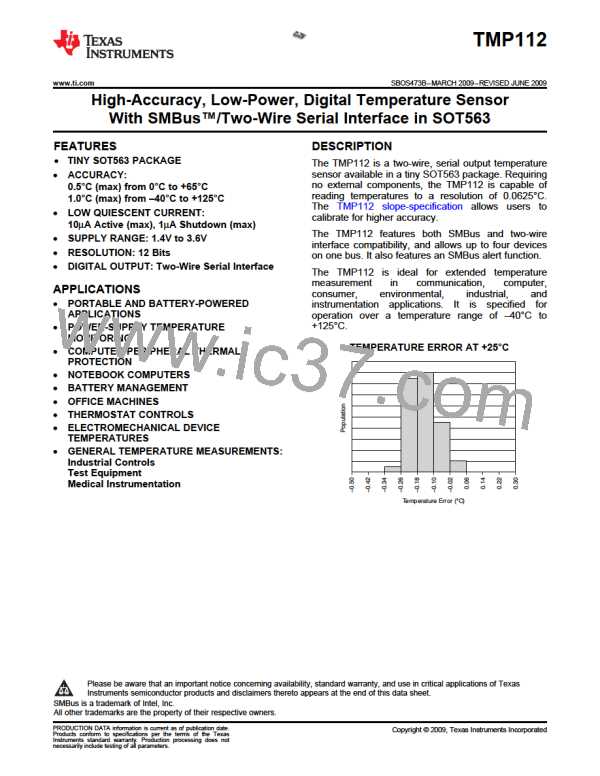TMP112
SBOS473B–MARCH 2009–REVISED JUNE 2009 ......................................................................................................................................................... www.ti.com
reads from the same register are desired, it is not
necessary to continually send the Pointer Register
bytes, because the TMP112 remembers the Pointer
Register value until it is changed by the next write
operation.
For POL = '0', this bit is low if the temperature is
greater than or equal to THIGH; this bit is high if the
temperature is less than TLOW. The polarity of this bit
is inverted if POL = '1'. Refer to Figure 18 for details
of this sequence.
Note that register bytes are sent with the most
significant byte first, followed by the least significant
byte.
If multiple devices on the bus respond to the SMBus
Alert command, arbitration during the slave address
portion of the SMBus Alert command determines
which device clears its ALERT status. The device
with the lowest two-wire address wins the arbitration.
If the TMP112 wins the arbitration, its ALERT pin
becomes inactive at the completion of the SMBus
Alert command. If the TMP112 loses the arbitration,
its ALERT pin remains active.
SLAVE MODE OPERATIONS
The TMP112 can operate as a slave receiver or slave
transmitter. As a slave device, the TMP112 never
drives the SCL line.
Slave Receiver Mode:
GENERAL CALL
The first byte transmitted by the master is the slave
address, with the R/W bit low. The TMP112 then
acknowledges reception of a valid address. The next
byte transmitted by the master is the Pointer
Register. The TMP112 then acknowledges reception
of the Pointer Register byte. The next byte or bytes
are written to the register addressed by the Pointer
Register. The TMP112 acknowledges reception of
each data byte. The master can terminate data
transfer by generating a START or STOP condition.
The TMP112 responds to a two-wire General Call
address (0000000) if the eighth bit is '0'. The device
acknowledges the General Call address and
responds to commands in the second byte. If the
second byte is 00000110, the TMP112 internal
registers are reset to power-up values. The TMP112
does not support the General Address acquire
command.
HIGH-SPEED (Hs) MODE
Slave Transmitter Mode:
In order for the two-wire bus to operate at frequencies
above 400kHz, the master device must issue an
Hs-mode master code (00001xxx) as the first byte
after a START condition to switch the bus to
high-speed operation. The TMP112 does not
acknowledge this byte, but switches its input filters on
SDA and SCL and its output filters on SDA to operate
in Hs-mode, allowing transfers at up to 3.4MHz. After
the Hs-mode master code has been issued, the
master transmits a two-wire slave address to initiate a
data transfer operation. The bus continues to operate
in Hs-mode until a STOP condition occurs on the bus.
Upon receiving the STOP condition, the TMP112
switches the input and output filters back to
fast-mode operation.
The first byte transmitted by the master is the slave
address, with the R/W bit high. The slave
acknowledges reception of a valid slave address. The
next byte is transmitted by the slave and is the most
significant byte of the register indicated by the Pointer
Register. The master acknowledges reception of the
data byte. The next byte transmitted by the slave is
the least significant byte. The master acknowledges
reception of the data byte. The master can terminate
data transfer by generating a Not-Acknowledge on
reception of any data byte, or generating a START or
STOP condition.
SMBus ALERT FUNCTION
The TMP112 supports the SMBus Alert function.
When the TMP112 operates in Interrupt mode (TM =
'1'), the ALERT pin may be connected as an SMBus
Alert signal. When a master senses that an ALERT
condition is present on the ALERT line, the master
sends an SMBus Alert command (00011001) to the
bus. If the ALERT pin is active, the device
acknowledges the SMBus Alert command and
responds by returning its slave address on the SDA
line. The eighth bit (LSB) of the slave address byte
indicates if the ALERT condition was caused by the
TIMEOUT FUNCTION
The TMP112 resets the serial interface if SCL is held
low for 30ms (typ). The TMP112 releases the bus if it
is pulled low and waits for a START condition. To
avoid activating the timeout function, it is necessary
to maintain a communication speed of at least 1kHz
for SCL operating frequency.
temperature exceeding THIGH or falling below TLOW
.
12
Submit Documentation Feedback
Copyright © 2009, Texas Instruments Incorporated
Product Folder Link(s): TMP112

 TI [ TEXAS INSTRUMENTS ]
TI [ TEXAS INSTRUMENTS ]